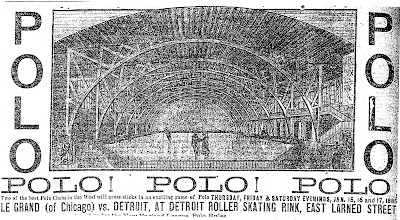Polo matches were the
rage from about 1884 through 1915 throughout Detroit and around the state. On a good weekend, you could find three or
four games being played somewhere in the city.
The players did not ride ponies, but rather skates – roller skates. The game was similar to ice hockey. It was played by twelve men, six on each
side, though it could be played by ten on a side. One player on each team guards the goal. A referee governs the contest. He calls “play” and “time” when the game is
begun or suspended. The referee also
decides what constitutes foul play.
During November 1890,
The Detroit Curling Club had installed a level wooden floor over the ground in
order to make ice with less water and easier to freeze. The floor was 85 feet wide by 160 long. At the time the members of the Detroit
Skating & Curling Club hoped that the new flat and level floor would
attract roller skaters. It did – Polo
Players. The Club boasted at least two
teams that played at Forest Avenue and toured around the state. The Detroit Free Press reported on February
7, 1892: “An exciting game of polo was played by well-matched teams of The
Detroit Skating & Curling Club. A
victory was gained by the Reds over the Blues by a score of 7 to 0.”
Roller Polo
Facts:
* The first game was played in
1878 in London, England.
* The US National Polo League was formed in Dayton,
Ohio in 1882.
* Roller Hockey (what the game is called today)
was an exhibition sport in the Summer Olympics in Barcelona, Spain in 1992.
Locally, the game is
played in Shelby Township. If you are
interested checkout the Little Caesars
Roller Hockey League at the Joe Dumars Field House. www.lcrh.info
Can “Polo Night in
America” on NBCSN be far behind?
What fools these
mortals be…
Angus MacTavish











